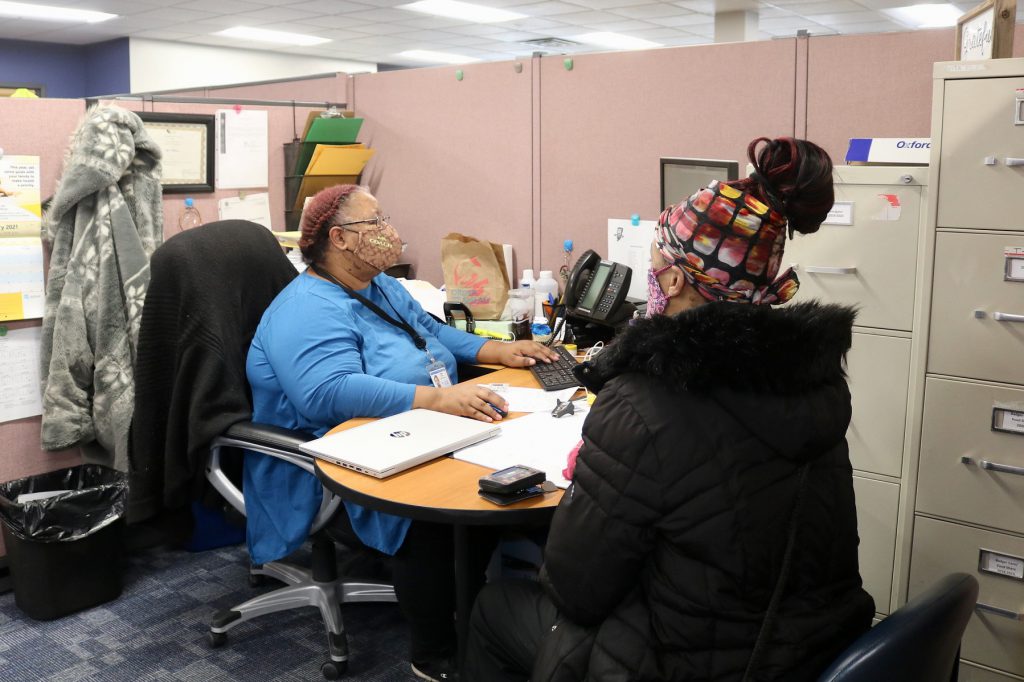How to Get Food Share Benefits
Biden’s executive order expands benefits. 5 things you need to know.

Shae Williams (left), a benefit specialist coordinator with the Social Development Commission, helps a client enroll in FoodShare. Photo provided by Kim Dawson-Brooks.
Over 700,000 Wisconsinites rely on the FoodShare program, which provides food benefits and other services to low-income households. Recipients spend their benefits on eligible food in authorized retail food stores.
President Joe Biden’s administration announced an executive order Jan. 22 that allows states to increase their maximum benefits for food assistance programs, such as Supplemental Nutrition Assistance Program and FoodShare, by 15%. FoodShare is generally distributed as a QUEST card that recipients can use to buy groceries.
Here’s what you need to know:
1. A single recipient could get up to $234 monthly
For FoodShare applicants in Wisconsin, that means a single recipient could receive up to $234 a month. Benefits scale along with the number of people in a household.
Sherrie Tussler, executive director of Hunger Task Force, said the executive order requires states to provide the maximum allowable household allotment to all FoodShare recipients. The increased benefits are expected to last until June.
The solution isn’t permanent, though. Tussler said it’s a matter of time before the maximum benefit will go away. She said long-term solutions are needed to help those struggling with food insecurity.
Tussler urged people who need food to apply for FoodShare and encouraged families with kids to check for eligibility for the Pandemic EBT.
Pandemic EBT is a food benefit specifically for kids who receive reduced-cost school lunches during the year. Since schools are mostly remote this year, the Pandemic EBT is meant to bridge the gap for kids. It can be added directly to a QUEST card or mailed as a separate card.
3. The process for enrolling
Shae Williams, a benefit specialist coordinator with Milwaukee’s Social Development Commission, helps people navigate the enrollment process. She sits down with people and does the application with them, going over paperwork they will need to apply.
Williams said people will need a form of identification for their application. They may also need a proof of residence, such as a rent receipt or utility bill and information for bank accounts.
Williams said some applications get approved almost immediately during the pandemic. She can be contacted at 414-906-2306.
4. Pandemic creates uptick in enrollment
The coronavirus has caused a major uptick in usage for these programs. A study from the Wisconsin Policy Forum estimates that FoodShare added 83,600 recipients between March and April of last year, at the beginning of the pandemic.
Despite recipients leveling off in the summer months, the study said that enrollment increased about 21% last year due to the pandemic.
According to the Wisconsin Department of Health Services, $1.3 billion was distributed through the FoodShare program in 2020, an increase from $773 million in 2019. Money given through the program is provided by the federal government, though it is distributed by the state of Wisconsin.
Over $476 million of that total went to Milwaukee County.
5. How you can enroll
People looking to enroll in the program can visit access.wi.gov. Those in Milwaukee County can also contact Milwaukee Enrollment Services at 1-888-947-6583 Monday through Friday from 8 a.m. to 4:30 p.m. That number can be used to receive support in enrolling online.
The Department of Health Services has infographics available in English, Spanish and Hmong explaining the benefits increase.
This story was originally published by Milwaukee Neighborhood News Service, where you can find other stories reporting on fifteen city neighborhoods in Milwaukee.


















